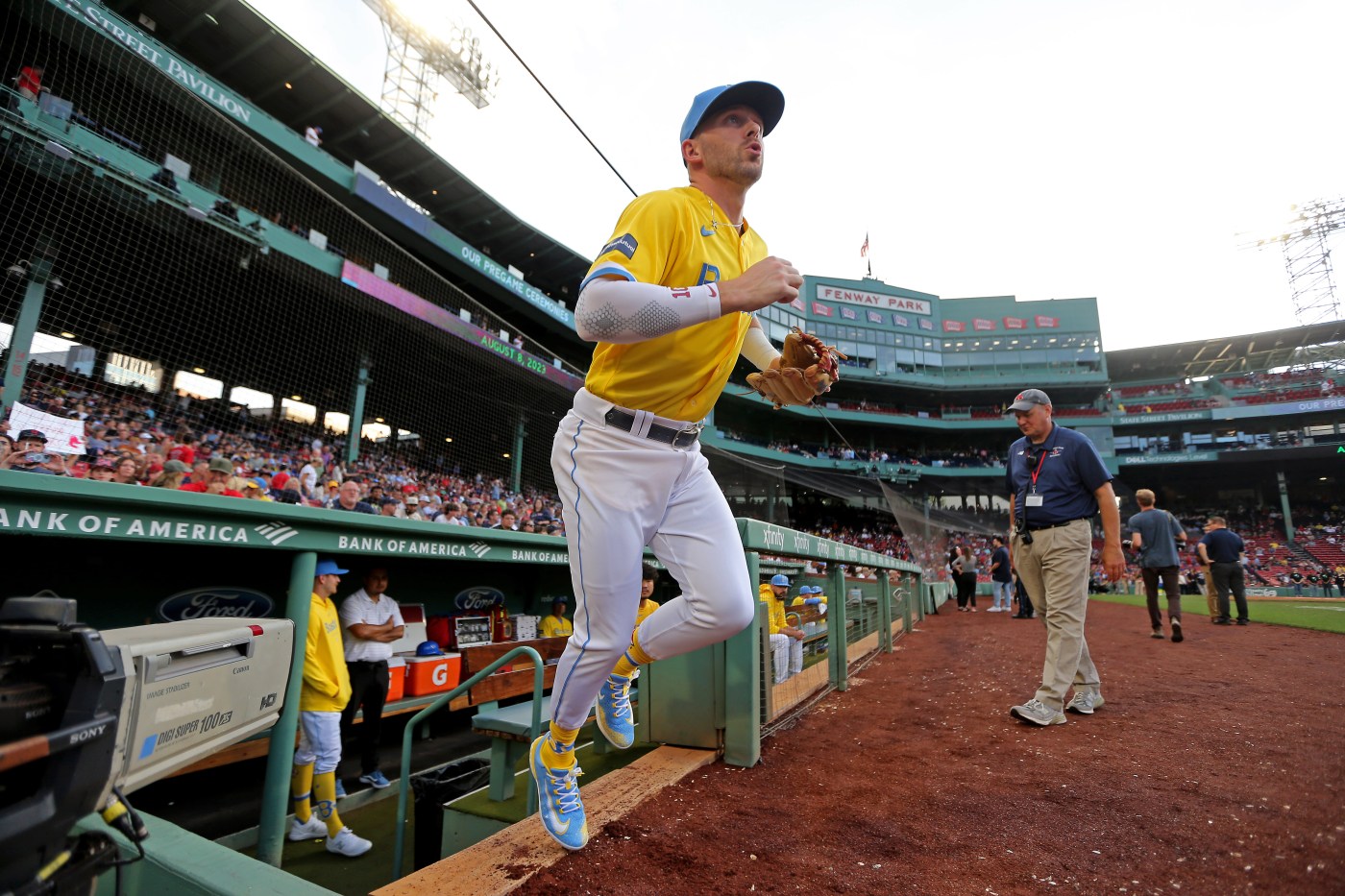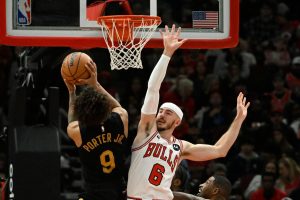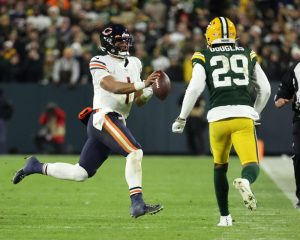
MLB Notes: Red Sox lineup still needs work heading into 2024
Who the Red Sox add to the starting rotation has dominated the conversation all offseason long, and most of the winter it’s felt like the sport’s held its breath waiting on Shohei Ohtani and Yoshinobu Yamamoto before any other business got done.
But while pitching remains a big question mark, the Red Sox lineup probably isn’t too far from a finished product.
The Red Sox have been vocal about their desire to add a right-handed bat, and they’ve already gotten one by trading for outfielder Tyler O’Neill to fill the void left by Alex Verdugo. The club also needs an upgrade at second base, and a reunion with designated hitter Justin Turner can’t be ruled out, but by and large we should have a good idea of what Boston’s lineup could look like on Opening Day.
With the roster as currently constructed, here’s what the Red Sox are working with.
Projected lineup
Jarren Duran LF, Masataka Yoshida DH, Trevor Story SS, Rafael Devers 3B, Triston Casas 1B, Tyler O’Neill CF, Wilyer Abreu RF, Connor Wong C, Pablo Reyes 2B
This isn’t a bad lineup, but there are two obvious issues that jump out immediately. One is it tilts heavily left-handed and is impossible to balance without batting someone like Masataka Yoshida or Triston Casas sixth. The other is it puts a lot of pressure on young players like Jarren Duran, Casas and rookie Wilyer Abreu to produce. If they don’t the whole thing could fall apart.
Regardless of what the Red Sox do to shore things up, the performance of Trevor Story and Casas will be key.
Story’s had a tough run since coming to Boston, but most of his setbacks have been explainable. He signed with the Red Sox in late March of 2022 due to the lockout and struggled after getting barely a week of spring training. Then he got hit by a pitch and broke his wrist.
Finally his elbow gave out, and even after returning last August he could never find his timing at the plate. But before all of that Story was a dependable and dynamic shortstop who reliably hit 20-30 home runs a year. Now back to full health, the Red Sox are counting on that version of Story to return.
As for Casas, he just hit 24 home runs as a 23-year-old rookie and batted .317 with a 1.034 OPS in the second half. If he can maintain anywhere close to that level of production over a full season, watch out.
Projected bench
Reese McGuire C, Enmanuel Valdez INF, Rob Refsnyder OF, Ceddanne Rafaela INF/OF
Reese McGuire and Rob Refsnyder are locked into their current roles, and Valdez would probably be bumped to Triple-A and Pablo Reyes moved into a more appropriate bench role if Boston acquires a new second baseman. The most interesting question here is how Ceddanne Rafaela factors into the equation.
On one hand, Rafaela is the best defensive center fielder on the team and can also slot in at shortstop and second base depending on the needs of a given day. On the other hand, his offensive approach still needs seasoning and he might be better suited for everyday at bats in Triple-A than as a utility man off the bench in the big leagues.
Areas of improvement
There are two obvious ways the Red Sox could still improve: finding an everyday second baseman and adding another right-handed hitting outfielder.
An outfielder would be the easiest way to add more thump. O’Neill could be that guy — he did hit 34 home runs in 2021 — but outside of that he’s never been an everyday starter. Bringing back Turner would bolster the lineup while allowing O’Neill to platoon with Yoshida, Duran and Abreu, but that would also limit Boston’s ceiling defensively.
A reunion with Adam Duvall might actually make the most sense. He’s coming off a productive season with the Red Sox and could most likely be had on only a one- or two-year deal. He’d also take the pressure off Abreu to produce, but the Red Sox have been so high on the rookie they might feel better off giving him a chance to be the guy in right field.
As for second base, most of the best available options would be more glove-first than bat-first, but there are a couple who could make a meaningful difference. For example, Brandon Drury hit 26 home runs last year and saw significant time batting No. 3 for the Angels. Whit Merrifield, the top free agent second baseman, also boasts game-changing speed, though he’d be more likely to slot in the No. 6-7 spots.
If the Red Sox were to add both Duvall and Drury, or right-handed hitters of similar quality at their positions, they’d easily have a top 10 lineup in baseball and enough depth to compete over a long 162-game season. Without any more additions they could still be pretty good, but this team is likely at least one bat away.
Past inaction catching up with Sox
Now that Yamamoto has signed, the rest of the pitching market should start picking up. Even without the offseason’s top prize there are still arms up for grabs who could help turn around the club’s depleted starting rotation, but the Red Sox can’t afford to wait around much longer.
The fact that things have reached this point goes to show how costly the club’s past inaction has been.
Think of all the times the Red Sox could have landed a quality starting pitcher on a respectable 3-5 year deal over the past few years but didn’t. That pitcher would have not only helped fortify the club’s rotation and possibly prevented either of the past two last place finishes, but they’d likely have been more affordable than anyone the Red Sox get now.
The big what-if is Kevin Gausman, who signed a five-year, $110 million contract with Toronto in 2022 and has been one of the best pitchers in baseball ever since. Gausman was a Cy Young finalist who posted a 3.16 ERA with 237 strikeouts in 185 innings this past season, but despite rumors the Red Sox were in on him prior to 2022, Gausman told MassLive that he never heard from Boston during his free agency.
More recently, the Red Sox were beaten out last winter by the Tampa Bay Rays for Zach Eflin, who reportedly chose between two identical three-year, $40 million offers. An Orlando native, Eflin reportedly took Boston’s initial offer to Tampa Bay and signed when they agreed to match it. Hindsight is definitely 20/20, but had the Red Sox sweetened the pot just a little bit, maybe the deal would have been too rich for the Rays and Boston would’ve been the one benefitting from his 3.50 ERA over 177.2 innings.
Then there’s Nathan Eovaldi, who wound up in Texas this past offseason after he and the Red Sox couldn’t line up on a new deal. This one it’s tough to blame either side, because the Red Sox reportedly offered Eovaldi a three-year, $51 million deal that would have been larger than the two-year, $34 million contract he ultimately signed with Texas, but Eovaldi opted to hold out for a bigger deal and by the time he was ready the Red Sox had already pivoted to other players, including Kenley Jansen, Chris Martin, Masataka Yoshida and Justin Turner.
Things obviously worked out just fine for Eovaldi, who went 5-0 for the Rangers in the playoffs and won the championship-clinching Game 5 of the World Series.
Boston’s outlook would be so much brighter if they’d landed any of these three, but the past is the past and failing to land quality pitching before shouldn’t stop them from doing so now.
Early trends look good for Beltre, Mauer
This year’s Baseball Hall of Fame vote doesn’t close until Dec. 31, but thanks to the tireless work of Ryan Thibodaux and his Hall of Fame Tracker team, an early picture is beginning to emerge of how this year’s vote may play out.
And so far things are looking pretty good for first-year candidates Adrian Beltre and Joe Mauer.
As of this writing only 37 ballots have been made public, good for less than 10% of the total projected vote, but based on those ballots Beltre looks set to comfortably cruise into Cooperstown on the first ballot, while Mauer is trending in the right direction as well. So far Beltre has appeared on all but one ballot that’s been revealed (97.3%), while Mauer has received 28 votes, good for 75.7% of the known total and just clear of the 75% threshold needed for induction.
Ex-Rockies great Todd Helton, who fell just short of induction last year with 72.2%, is also on pace to earn enshrinement in his sixth try with 81.1%,
Gary Sheffield (67.6%) is well above his total last year (55%) but looks likely to fall short in his final year on the ballot. Andruw Jones (62.2%), Billy Wagner (62.2%), Carlos Beltran (59.5%) and first-year candidate Chase Utley (56.8%) don’t look likely to earn enshrinement this year either but are posting impressive totals that bode well for their future outlook.
Manny Ramirez and Alex Rodriguez, once considered Hall of Fame locks before testing positive for performance enhancing drugs as players, are still not drawing nearly enough support to suggest future enshrinement with 43.2% and 40.5%, respectively.


